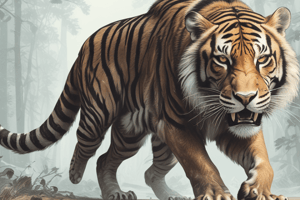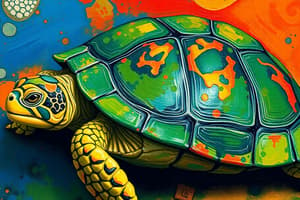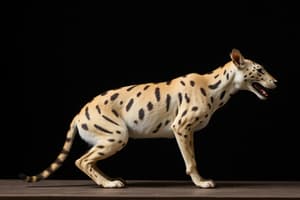Podcast
Questions and Answers
The brain is regarded as the seat of ______ and higher mental processes.
The brain is regarded as the seat of ______ and higher mental processes.
consciousness
The Peripheral Nervous System lies outside the bony case of the skull and the spinal ______.
The Peripheral Nervous System lies outside the bony case of the skull and the spinal ______.
cord
The two main divisions of the PNS are the Autonomic NS and the ______ NS.
The two main divisions of the PNS are the Autonomic NS and the ______ NS.
Somatic
The ___________ division of the ANS calms the body and restores functions to normal.
The ___________ division of the ANS calms the body and restores functions to normal.
The spinal cord is the main pathway for ______ and motor impulses.
The spinal cord is the main pathway for ______ and motor impulses.
Over-secretion of Growth Hormone can lead to conditions such as Giantism and ___________.
Over-secretion of Growth Hormone can lead to conditions such as Giantism and ___________.
The brainstem includes the pons, medulla, and ______.
The brainstem includes the pons, medulla, and ______.
The ___________ gland is known as the master gland and regulates other glands.
The ___________ gland is known as the master gland and regulates other glands.
The ___________ division of the ANS prepares the body for stressful situations.
The ___________ division of the ANS prepares the body for stressful situations.
The midbrain is known as the ______ and is the smallest part of the brainstem.
The midbrain is known as the ______ and is the smallest part of the brainstem.
The Autonomic Nervous System controls functions that are not under ______ control.
The Autonomic Nervous System controls functions that are not under ______ control.
The Anterior Lobe of the Pituitary Gland secretes the Growth Hormone, also known as ___________ hormone.
The Anterior Lobe of the Pituitary Gland secretes the Growth Hormone, also known as ___________ hormone.
The cerebellum contributes to our sense of ______ and helps coordinate smooth muscle movement.
The cerebellum contributes to our sense of ______ and helps coordinate smooth muscle movement.
The limbic system is heavily involved in emotions, learning, memory, and the experience of ______.
The limbic system is heavily involved in emotions, learning, memory, and the experience of ______.
The ______ is responsible for regulating vital bodily functions, such as heartbeat and breathing.
The ______ is responsible for regulating vital bodily functions, such as heartbeat and breathing.
The pons is located just above the ______ and is crucial for coordination of movement.
The pons is located just above the ______ and is crucial for coordination of movement.
The ______ explanation focuses on the purpose or function of behavior.
The ______ explanation focuses on the purpose or function of behavior.
The ______ system contains the brain and spinal cord.
The ______ system contains the brain and spinal cord.
The ______ explanation maps the influences of nutrition and genes in producing behaviors.
The ______ explanation maps the influences of nutrition and genes in producing behaviors.
The major instrument of integration and coordination of the many activities regarding human behavior is the ______ system.
The major instrument of integration and coordination of the many activities regarding human behavior is the ______ system.
Glutamate is the most commonly found ______ neurotransmitter in the brain.
Glutamate is the most commonly found ______ neurotransmitter in the brain.
Astrocytes are a type of supporting cell in the nervous system that helps protect the cell from ______ substances.
Astrocytes are a type of supporting cell in the nervous system that helps protect the cell from ______ substances.
Nicotine imitates the action of ______ and binds to ACh receptors.
Nicotine imitates the action of ______ and binds to ACh receptors.
The ______ nervous system affects the cardiac muscles and operates involuntarily.
The ______ nervous system affects the cardiac muscles and operates involuntarily.
The external part of the adrenal gland is known as the adrenal ______.
The external part of the adrenal gland is known as the adrenal ______.
Excessive fatigue and loss of appetite can result from undersecretion of ______.
Excessive fatigue and loss of appetite can result from undersecretion of ______.
The ______ division is responsible for carrying sensory information to the central nervous system.
The ______ division is responsible for carrying sensory information to the central nervous system.
The pancreas is responsible for secreting ______ to control blood sugar levels.
The pancreas is responsible for secreting ______ to control blood sugar levels.
The ______ nervous system controls skeletal muscles.
The ______ nervous system controls skeletal muscles.
The adrenal glands are located at the back of the body above the ______.
The adrenal glands are located at the back of the body above the ______.
Epilepsy is associated with a deficiency in the neurotransmitter ______.
Epilepsy is associated with a deficiency in the neurotransmitter ______.
The adrenal medulla secretes ______, which is important during emotional stress.
The adrenal medulla secretes ______, which is important during emotional stress.
When the sugar level in the blood drops, the liver releases more glucose in response to ______.
When the sugar level in the blood drops, the liver releases more glucose in response to ______.
Neurotransmitters are chemical messengers that transmit signals across a ______.
Neurotransmitters are chemical messengers that transmit signals across a ______.
Serotonin is known as the happy hormone that is involved with mood, pain, control, and ______.
Serotonin is known as the happy hormone that is involved with mood, pain, control, and ______.
Neurotransmitters are packaged into synaptic ______ on the presynaptic side.
Neurotransmitters are packaged into synaptic ______ on the presynaptic side.
Alcohol binds directly to receptors for ______, serotonin, GABA, and glutamate.
Alcohol binds directly to receptors for ______, serotonin, GABA, and glutamate.
Alcohol enhances the effects of GABA, which is an ______ neurotransmitter.
Alcohol enhances the effects of GABA, which is an ______ neurotransmitter.
A depletion of norepinephrine, serotonin, and ______ in the central nervous system is believed to cause depression.
A depletion of norepinephrine, serotonin, and ______ in the central nervous system is believed to cause depression.
Diseases associated with dopamine include Parkinson's disease and ______.
Diseases associated with dopamine include Parkinson's disease and ______.
Flashcards are hidden until you start studying
Study Notes
Behavioral Explanations of Camouflage
- Physiological Explanation: Links behavior to brain activity and physiological processes, influencing how organisms respond to their environment.
- Ontogenetic Explanation: Explains behavior development through nutrition, genes, experiences, and their interactions throughout an organism's life.
- Evolutionary Explanation: Examines how certain behaviors have evolved over time to improve chances of survival and reproduction.
- Functional Explanation: Addresses the purpose of behaviors, originating from internal drives, external rewards, conditioning, and social interactions.
Physiological Basis of Behavior
- Physiological Psychology: Studies responses of the body and how internal stimuli lead to action via mechanisms.
- Mechanisms of Response:
- Receiving Mechanisms: Detect environmental stimuli.
- Connecting Mechanisms: Integrate and process sensory information.
- Reacting Mechanisms: Execute responses based on processed information.
Nervous System Overview
-
Role of the Nervous System:
- Monitors environmental changes.
- Processes sensory information.
- Manages bodily responses.
- Regulates mental activity.
- Maintains homeostasis.
-
Structural Classification:
- Central Nervous System (CNS): Comprises the brain and spinal cord.
- Peripheral Nervous System (PNS): Comprises nerves outside of the CNS.
-
Functional Classification:
- Sensory/Afferent division: Transmits sensory information to the CNS.
- Motor/Efferent division: Carries signals from the CNS to effectors in the body.
Components of the Nervous System
- Somatic Nervous System: Controls voluntary muscular movements.
- Autonomic Nervous System: Regulates involuntary functions, sub-divided into:
- Sympathetic Nervous System: Prepares body for stress (fight or flight response).
- Parasympathetic Nervous System: Calms the body post-stress, regulating normal functions.
Major Structures of the Brain
-
Central Core (Old Brain): Includes brainstem and cerebellum; essential for basic life functions.
-
Brainstem: Connects brain to spinal cord; maintains vital functions.
- Medulla: Regulates heart rate, blood circulation, and respiration.
- Pons: Coordinates movements and integrates signals between brain parts.
- Midbrain: Smallest part that handles crucial reflexes and motor functions.
-
Cerebellum: Coordinates muscle movements, balance, and posture.
Limbic System
- Regulates emotions, learning, and memory.
- Vital for experiencing pleasure and emotional responses.
Glands and Hormones
- Endocrine Glands: Release hormones directly into the bloodstream; examples include the pituitary and adrenal glands.
- Pituitary Gland: Known as the master gland; regulates other glands and hormone secretion.
- Adrenal Glands:
- Adrenal Cortex: Releases hormones affecting stress response and energy management.
- Adrenal Medulla: Produces adrenaline; enhances physical responses to stress.
- Pancreas: Secretes insulin for blood sugar regulation; key in diabetes management.
Neurotransmitters
- Definition: Chemical messengers facilitating communication between neurons at synapses.
- Serotonin: Regulates mood and cognition; linked to depression when levels are low.
- Glutamate: Most abundant excitatory neurotransmitter; crucial for normal brain functions including memory.
- Alcohol Effects: Enhances GABA (inhibitory neurotransmitter) effects, leading to sedative effects; impairs glutamate function, causing cognitive disruptions.
- Nicotine: Stimulates release of neurotransmitters like dopamine, linking to addiction.
Diseases Associated with Neurotransmitters
- Acetylcholine: Alzheimer's disease linked to its deficiency.
- Dopamine: Associated with Parkinson's disease and schizophrenia.
- GABA: Linked to epilepsy.
- Serotonin: Related to migraines, depression, and Attention Deficit Disorder.
- Glutamate: Implicated in migraines and strokes.
Studying That Suits You
Use AI to generate personalized quizzes and flashcards to suit your learning preferences.





